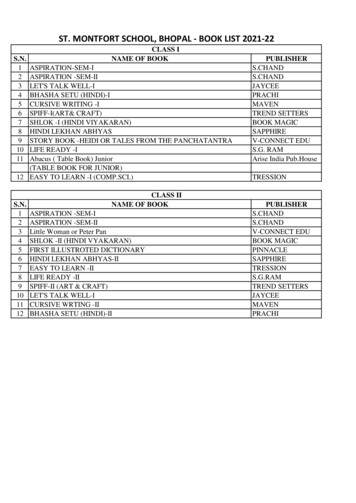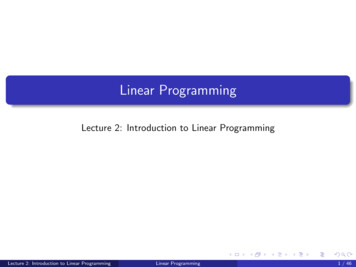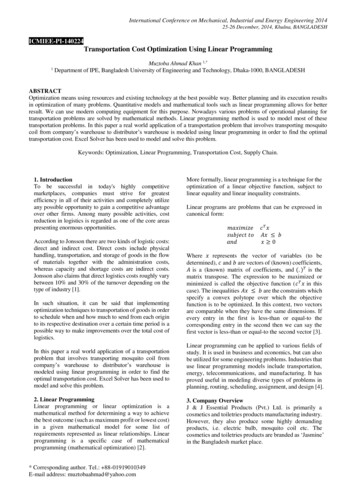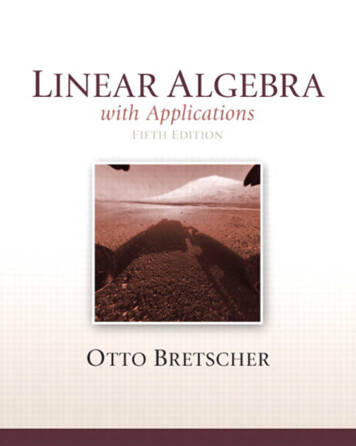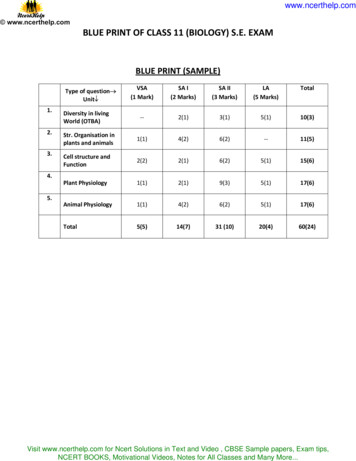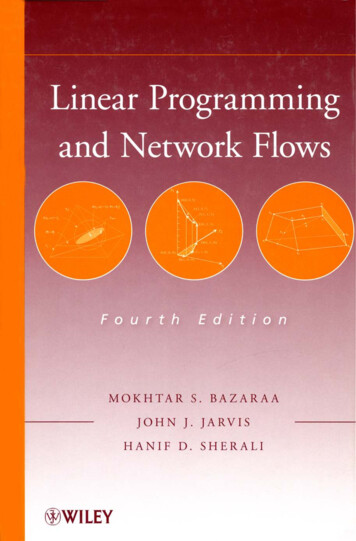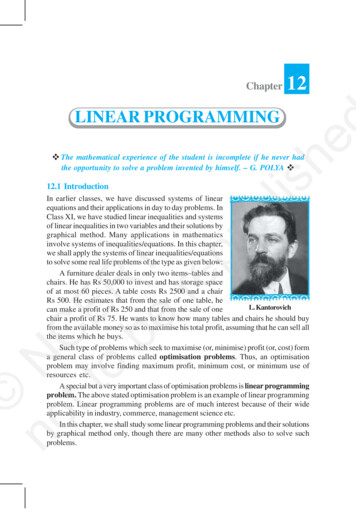
Transcription
504MATHEMATICSChapter12heLINEAR PROGRAMMING12.1 Introductionis The mathematical experience of the student is incomplete if he never hadthe opportunity to solve a problem invented by himself. – G. POLYA no NCtt Eo Rbe TrepublIn earlier classes, we have discussed systems of linearequations and their applications in day to day problems. InClass XI, we have studied linear inequalities and systemsof linear inequalities in two variables and their solutions bygraphical method. Many applications in mathematicsinvolve systems of inequalities/equations. In this chapter,we shall apply the systems of linear inequalities/equationsto solve some real life problems of the type as given below:A furniture dealer deals in only two items–tables andchairs. He has Rs 50,000 to invest and has storage spaceof at most 60 pieces. A table costs Rs 2500 and a chairRs 500. He estimates that from the sale of one table, heL. Kantorovichcan make a profit of Rs 250 and that from the sale of onechair a profit of Rs 75. He wants to know how many tables and chairs he should buyfrom the available money so as to maximise his total profit, assuming that he can sell allthe items which he buys.Such type of problems which seek to maximise (or, minimise) profit (or, cost) forma general class of problems called optimisation problems. Thus, an optimisationproblem may involve finding maximum profit, minimum cost, or minimum use ofresources etc.A special but a very important class of optimisation problems is linear programmingproblem. The above stated optimisation problem is an example of linear programmingproblem. Linear programming problems are of much interest because of their wideapplicability in industry, commerce, management science etc.In this chapter, we shall study some linear programming problems and their solutionsby graphical method only, though there are many other methods also to solve suchproblems.
LINEAR PROGRAMMING50512.2 Linear Programming Problem and its Mathematical Formulation no NCtt Eo Rbe TrepublisheWe begin our discussion with the above example of furniture dealer which will furtherlead to a mathematical formulation of the problem in two variables. In this example, weobserve(i) The dealer can invest his money in buying tables or chairs or combination thereof.Further he would earn different profits by following different investmentstrategies.(ii) There are certain overriding conditions or constraints viz., his investment islimited to a maximum of Rs 50,000 and so is his storage space which is for amaximum of 60 pieces.Suppose he decides to buy tables only and no chairs, so he can buy 50000 2500,i.e., 20 tables. His profit in this case will be Rs (250 20), i.e., Rs 5000.Suppose he chooses to buy chairs only and no tables. With his capital of Rs 50,000,he can buy 50000 500, i.e. 100 chairs. But he can store only 60 pieces. Therefore, heis forced to buy only 60 chairs which will give him a total profit of Rs (60 75), i.e.,Rs 4500.There are many other possibilities, for instance, he may choose to buy 10 tablesand 50 chairs, as he can store only 60 pieces. Total profit in this case would beRs (10 250 50 75), i.e., Rs 6250 and so on.We, thus, find that the dealer can invest his money in different ways and he wouldearn different profits by following different investment strategies.Now the problem is : How should he invest his money in order to get maximumprofit? To answer this question, let us try to formulate the problem mathematically.12.2.1 Mathematical formulation of the problemLet x be the number of tables and y be the number of chairs that the dealer buys.Obviously, x and y must be non-negative, i.e.,x 0(Non-negative constraints)y 0. (1). (2)The dealer is constrained by the maximum amount he can invest (Here it isRs 50,000) and by the maximum number of items he can store (Here it is 60).Stated mathematically,orand2500x 500y 50000 (investment constraint)5x y 100x y 60 (storage constraint). (3). (4)
506MATHEMATICSheThe dealer wants to invest in such a way so as to maximise his profit, say, Z whichstated as a function of x and y is given byZ 250x 75y (called objective function). (5)Mathematically, the given problems now reduces to:Maximise Z 250x 75ysubject to the constraints:5x y 100x 0, y 0isx y 60 no NCtt Eo Rbe TrepublSo, we have to maximise the linear function Z subject to certain conditions determinedby a set of linear inequalities with variables as non-negative. There are also some otherproblems where we have to minimise a linear function subject to certain conditionsdetermined by a set of linear inequalities with variables as non-negative. Such problemsare called Linear Programming Problems.Thus, a Linear Programming Problem is one that is concerned with finding theoptimal value (maximum or minimum value) of a linear function (called objectivefunction) of several variables (say x and y), subject to the conditions that the variablesare non-negative and satisfy a set of linear inequalities (called linear constraints).The term linear implies that all the mathematical relations used in the problem arelinear relations while the term programming refers to the method of determining aparticular programme or plan of action.Before we proceed further, we now formally define some terms (which have beenused above) which we shall be using in the linear programming problems:Objective function Linear function Z ax by, where a, b are constants, which hasto be maximised or minimized is called a linear objective function.In the above example, Z 250x 75y is a linear objective function. Variables x andy are called decision variables.Constraints The linear inequalities or equations or restrictions on the variables of alinear programming problem are called constraints. The conditions x 0, y 0 arecalled non-negative restrictions. In the above example, the set of inequalities (1) to (4)are constraints.Optimisation problem A problem which seeks to maximise or minimise a linearfunction (say of two variables x and y) subject to certain constraints as determined bya set of linear inequalities is called an optimisation problem. Linear programmingproblems are special type of optimisation problems. The above problem of investing a
LINEAR PROGRAMMING507given sum by the dealer in purchasing chairs and tables is an example of an optimisationproblem as well as of a linear programming problem.We will now discuss how to find solutions to a linear programming problem. In thischapter, we will be concerned only with the graphical method.x 0y 0isx y 60. (1). (2). (3)bl5x y 100he12.2.2 Graphical method of solving linear programming problemsIn Class XI, we have learnt how to graph a system of linear inequalities involving twovariables x and y and to find its solutions graphically. Let us refer to the problem ofinvestment in tables and chairs discussed in Section 12.2. We will now solve this problemgraphically. Let us graph the constraints stated as linear inequalities:. (4) no NCtt Eo Rbe TrepuThe graph of this system (shaded region) consists of the points common to all halfplanes determined by the inequalities (1) to (4) (Fig 12.1). Each point in this regionrepresents a feasible choice open to the dealer for investing in tables and chairs. Theregion, therefore, is called the feasible region for the problem. Every point of thisregion is called a feasible solution to the problem. Thus, we have,Feasible region The common region determined by all the constraints includingnon-negative constraints x, y 0 of a linear programming problem is called the feasibleregion (or solution region) for the problem. In Fig 12.1, the region OABC (shaded) isthe feasible region for the problem. The region other than feasible region is called aninfeasible region.Feasible solutions Points within and on theboundary of the feasible region representfeasible solutions of the constraints. InFig 12.1, every point within and on theboundary of the feasible region OABCrepresents feasible solution to the problem.For example, the point (10, 50) is a feasiblesolution of the problem and so are the points(0, 60), (20, 0) etc.Any point outside the feasible region iscalled an infeasible solution. For example,the point (25, 40) is an infeasible solution ofthe problem.Fig 12.1
508MATHEMATICSOptimal (feasible) solution: Any point in the feasible region that gives the optimalvalue (maximum or minimum) of the objective function is called an optimal solution.heNow, we see that every point in the feasible region OABC satisfies all the constraintsas given in (1) to (4), and since there are infinitely many points, it is not evident howwe should go about finding a point that gives a maximum value of the objective functionZ 250x 75y. To handle this situation, we use the following theorems which arefundamental in solving linear programming problems. The proofs of these theoremsare beyond the scope of the book.blisTheorem 1 Let R be the feasible region (convex polygon) for a linear programmingproblem and let Z ax by be the objective function. When Z has an optimal value(maximum or minimum), where the variables x and y are subject to constraints describedby linear inequalities, this optimal value must occur at a corner point* (vertex) of thefeasible region. no NCtt Eo Rbe TrepuTheorem 2 Let R be the feasible region for a linear programming problem, and letZ ax by be the objective function. If R is bounded**, then the objective functionZ has both a maximum and a minimum value on R and each of these occurs at acorner point (vertex) of R.Remark If R is unbounded, then a maximum or a minimum value of the objectivefunction may not exist. However, if it exists, it must occur at a corner point of R.(By Theorem 1).In the above example, the corner points (vertices) of the bounded (feasible) regionare: O, A, B and C and it is easy to find their coordinates as (0, 0), (20, 0), (10, 50) and(0, 60) respectively. Let us now compute the values of Z at these points.We haveVertex of theFeasible RegionO (0,0)C (0,60)B (10,50)A (20,0)Corresponding valueof Z (in Rs)0450062505000 Maximum* A corner point of a feasible region is a point in the region which is the intersection of two boundary lines.** A feasible region of a system of linear inequalities is said to be bounded if it can be enclosed within acircle. Otherwise, it is called unbounded. Unbounded means that the feasible region does extendindefinitely in any direction.
LINEAR PROGRAMMING509We observe that the maximum profit to the dealer results from the investmentstrategy (10, 50), i.e. buying 10 tables and 50 chairs.This method of solving linear programming problem is referred as Corner PointMethod. The method comprises of the following steps:he1. Find the feasible region of the linear programming problem and determine itscorner points (vertices) either by inspection or by solving the two equations ofthe lines intersecting at that point.is2. Evaluate the objective function Z ax by at each corner point. Let M and m,respectively denote the largest and smallest values of these points.bl3. (i) When the feasible region is bounded, M and m are the maximum andminimum values of Z.(ii) In case, the feasible region is unbounded, we have: no NCtt Eo Rbe Trepu4. (a) M is the maximum value of Z, if the open half plane determined byax by M has no point in common with the feasible region. Otherwise, Zhas no maximum value.(b) Similarly, m is the minimum value of Z, if the open half plane determined byax by m has no point in common with the feasible region. Otherwise, Zhas no minimum value.We will now illustrate these steps of Corner Point Method by considering someexamples:Example 1 Solve the following linear programming problem graphically:Maximise Z 4x y. (1)subject to the constraints:x y 50. (2)3x y 90. (3)x 0, y 0. (4)Solution The shaded region in Fig 12.2 is the feasible region determined by the systemof constraints (2) to (4). We observe that the feasible region OABC is bounded. So,we now use Corner Point Method to determine the maximum value of Z.The coordinates of the corner points O, A, B and C are (0, 0), (30, 0), (20, 30) and(0, 50) respectively. Now we evaluate Z at each corner point.
510MATHEMATICSCorner Point Corresponding valueof Z Maximumhe012011050Fig 12.2blis(0, 0)(30, 0)(20, 30)(0, 50)Hence, maximum value of Z is 120 at the point (30, 0). no NCtt Eo Rbe TrepuExample 2 Solve the following linear programming problem graphically:Minimise Z 200 x 500 ysubject to the constraints:x 2y 103x 4y 24x 0, y 0. (1). (2). (3). (4)Solution The shaded region in Fig 12.3 is the feasible region ABC determined by thesystem of constraints (2) to (4), which is bounded. The coordinates of corner pointsCorner Point Corresponding valueof Z(0, 5)(4, 3)(0, 6)Fig 12.3250023003000 Minimum
LINEAR PROGRAMMING511A, B and C are (0,5), (4,3) and (0,6) respectively. Now we evaluate Z 200x 500yat these points.Hence, minimum value of Z is 2300 attained at the point (4, 3)Example 3 Solve the following problem graphically:Minimise and Maximise Z 3x 9ysubject to the constraints:x 3y 60x y 10x yhe(1)(2)(3)(4). (5)isx 0, y 0. no NCtt Eo Rbe TrepublSolution First of all, let us graph the feasible region of the system of linear inequalities(2) to (5). The feasible region ABCD is shown in the Fig 12.4. Note that the region isbounded. The coordinates of the corner points A, B, C and D are (0, 10), (5, 5), (15,15)and (0, 20) respectively.CornerPointA (0, 10)B (5, 5)C (15, 15)D (0, 20)Corresponding value ofZ 3x 9y9060180180 } MinimumMaximum(Multipleoptimalsolutions)Fig 12.4We now find the minimum and maximum value of Z. From the table, we find thatthe minimum value of Z is 60 at the point B (5, 5) of the feasible region.The maximum value of Z on the feasible region occurs at the two corner pointsC (15, 15) and D (0, 20) and it is 180 in each case.Remark Observe that in the above example, the problem has multiple optimal solutionsat the corner points C and D, i.e. the both points produce same maximum value 180. Insuch cases, you can see that every point on the line segment CD joining the two cornerpoints C and D also give the same maximum value. Same is also true in the case if thetwo points produce same minimum value.
512MATHEMATICS(1)(2)(3)(4)(5)heExample 4 Determine graphically the minimum value of the objective functionZ – 50x 20y.subject to the constraints:2x – y – 5.3x y 3.2x – 3y 12.x 0, y 0. no NCtt Eo Rbe TrepublisSolution First of all, let us graph the feasible region of the system of inequalities (2) to(5). The feasible region (shaded) is shown in the Fig 12.5. Observe that the feasibleregion is unbounded.We now evaluate Z at the corner points.Corner PointZ – 50x 20y(0, 5)(0, 3)(1, 0)(6, 0)10060–50– 300 smallestFig 12.5From this table, we find that – 300 is the smallest value of Z at the corner point(6, 0). Can we say that minimum value of Z is – 300? Note that if the region wouldhave been bounded, this smallest value of Z is the minimum value of Z (Theorem 2).But here we see that the feasible region is unbounded. Therefore, – 300 may or maynot be the minimum value of Z. To decide this issue, we graph the inequality– 50x 20y – 300 (see Step 3(ii) of corner Point Method.)i.e.,– 5x 2y – 30and check whether the resulting open half plane has points in common with feasibleregion or not. If it has common points, then –300 will not be the minimum value of Z.Otherwise, –300 will be the minimum value of Z.
LINEAR PROGRAMMING513As shown in the Fig 12.5, it has common points. Therefore, Z –50 x 20 yhas no minimum value subject to the given constraints.heIn the above example, can you say whether z – 50 x 20 y has the maximumvalue 100 at (0,5)? For this, check whether the graph of – 50 x 20 y 100 has pointsin common with the feasible region. (Why?)Example 5 Minimise Z 3x 2ysubject to the constraints:x y 8. (1)3x 5y 15is. (2)x 0, y 0. (3) no NCtt Eo Rbe TrepuFrom Fig 12.6, you can see thatthere is no point satisfying all theconstraints simultaneously. Thus, theproblem is having no feasible region andhence no feasible solution.blSolution Let us graph the inequalities (1) to (3) (Fig 12.6). Is there any feasible region?Why is so?Remarks From the examples which wehave discussed so far, we notice somegeneral features of linear programmingproblems:(i) The feasible region is always aconvex region.Fig 12.6(ii) The maximum (or minimum)solution of the objective function occurs at the vertex (corner) of the feasibleregion. If two corner points produce the same maximum (or minimum) valueof the objective function, then every point on the line segment joining thesepoints will also give the same maximum (or minimum) value.EXERCISE 12.1Solve the following Linear Programming Problems graphically:1. Maximise Z 3x 4ysubject to the constraints : x y 4, x 0, y 0.
514MATHEMATICS2. Minimise Z – 3x 4 ysubject to x 2y 8, 3x 2y 12, x 0, y 0.3. Maximise Z 5x 3ysubject to 3x 5y 15, 5x 2y 10, x 0, y 0.he4. Minimise Z 3x 5ysuch that x 3y 3, x y 2, x, y 0.5. Maximise Z 3x 2y6. Minimise Z x 2ysubject to 2x y 3, x 2y 6, x, y 0.7. Minimise and Maximise Z 5x 10 yblShow that the minimum of Z occurs at more than two points.issubject to x 2y 10, 3x y 15, x, y 0. no NCtt Eo Rbe Trepusubject to x 2y 120, x y 60, x – 2y 0, x, y 0.8. Minimise and Maximise Z x 2ysubject to x 2y 100, 2x – y 0, 2x y 200; x, y 0.9. Maximise Z – x 2y, subject to the constraints:x 3, x y 5, x 2y 6, y 0.10. Maximise Z x y, subject to x – y –1, –x y 0, x, y 0.12.3 Different Types of Linear Programming ProblemsA few important linear programming problems are listed below:1. Manufacturing problems In these problems, we determine the number of unitsof different products which should be produced and sold by a firmwhen each product requires a fixed manpower, machine hours, labour hour perunit of product, warehouse space per unit of the output etc., in order to makemaximum profit.2. Diet problems In these problems, we determine the amount of different kindsof constituents/nutrients which should be included in a diet so as to minimise thecost of the desired diet such that it contains a certain minimum amount of eachconstituent/nutrients.3. Transportation problems In these problems, we determine a transportationschedule in order to find the cheapest way of transporting a product fromplants/factories situated at different locations to different markets.
LINEAR PROGRAMMING515Let us now solve some of these types of linear programming problems:heExample 6 (Diet problem): A dietician wishes to mix two types of foods in such away that vitamin contents of the mixture contain atleast 8 units of vitamin A and 10units of vitamin C. Food ‘I’ contains 2 units/kg of vitamin A and 1 unit/kg of vitamin C.Food ‘II’ contains 1 unit/kg of vitamin A and 2 units/kg of vitamin C. It costsRs 50 per kg to purchase Food ‘I’ and Rs 70 per kg to purchase Food ‘II’. Formulatethis problem as a linear programming problem to minimise the cost of such a mixture.RequirementII(y)218 no NCtt Eo Rbe TrepuVitamin A(units/kg)Vitamin C(units/kg)FoodI(x)blResourcesisSolution Let the mixture contain x kg of Food ‘I’ and y kg of Food ‘II’. Clearly, x 0,y 0. We make the following table from the given data:Cost (Rs/kg)12507010Since the mixture must contain at least 8 units of vitamin A and 10 units ofvitamin C, we have the constraints:2x y 8x 2y 10Total cost Z of purchasing x kg of food ‘I’ and y kg of Food ‘II’ isZ 50x 70yHence, the mathematical formulation of the problem is:MinimiseZ 50x 70y. (1)2x y 8. (2)x 2y 10. (3)subject to the constraints:x, y 0. (4)Let us graph the inequalities (2) to (4). The feasible region determined by thesystem is shown in the Fig 12.7. Here again, observe that the feasible region isunbounded.
516MATHEMATICSCorner PointZ 50x 70y560380500 Minimum no NCtt Eo Rbe TrepuFig 12.7blis(0,8)(2,4)(10,0)heLet us evaluate Z at the corner points A(0,8), B(2,4) and C(10,0).In the table, we find that smallest value of Z is 380 at the point (2,4). Can we saythat the minimum value of Z is 380? Remember that the feasible region is unbounded.Therefore, we have to draw the graph of the inequality50x 70y 380 i.e., 5x 7y 38to check whether the resulting open half plane has any point common with the feasibleregion. From the Fig 12.7, we see that it has no points in common.Thus, the minimum value of Z is 380 attained at the point (2, 4). Hence, the optimalmixing strategy for the dietician would be to mix 2 kg of Food ‘I’ and 4 kg of Food ‘II’,and with this strategy, the minimum cost of the mixture will be Rs 380.Example 7 (Allocation problem) A cooperative society of farmers has 50 hectareof land to grow two crops X and Y. The profit from crops X and Y per hectare areestimated as Rs 10,500 and Rs 9,000 respectively. To control weeds, a liquid herbicidehas to be used for crops X and Y at rates of 20 litres and 10 litres per hectare. Further,no more than 800 litres of herbicide should be used in order to protect fish and wild lifeusing a pond which collects drainage from this land. How much land should be allocatedto each crop so as to maximise the total profit of the society?Solution Let x hectare of land be allocated to crop X and y hectare to crop Y. Obviously,x 0, y 0.Profit per hectare on crop X Rs 10500Profit per hectare on crop Y Rs 9000Therefore, total profit Rs (10500x 9000y)
LINEAR PROGRAMMING517The mathematical formulation of the problem is as follows:MaximiseZ 10500 x 9000 ysubject to the constraints:x y 50 (constraint related to land). (1)i.e.he20x 10y 800 (constraint related to use of herbicide)2x y 80x 0, y 0. (2)(non negative constraint). (3)isLet us draw the graph of the system of inequalities (1) to (3). The feasible regionOABC is shown (shaded) in the Fig 12.8. Observe that the feasible region is bounded.blThe coordinates of the corner points O, A, B and C are (0, 0), (40, 0), (30, 20) and(0, 50) respectively. Let us evaluate the objective function Z 10500 x 9000y atthese vertices to find which one gives the maximum profit. no NCtt Eo Rbe TrepuCorner Point Z 10500x 9000yO (0, 0)0A ( 40, 0)420000B (30, 20)495000C (0,50)450000 MaximumFig 12.8Hence, the society will get the maximum profit of Rs 4,95,000 by allocating 30hectares for crop X and 20 hectares for crop Y.Example 8 (Manufacturing problem) A manufacturing company makes two modelsA and B of a product. Each piece of Model A requires 9 labour hours for fabricatingand 1 labour hour for finishing. Each piece of Model B requires 12 labour hours forfabricating and 3 labour hours for finishing. For fabricating and finishing, the maximumlabour hours available are 180 and 30 respectively. The company makes a profit ofRs 8000 on each piece of model A and Rs 12000 on each piece of Model B. How manypieces of Model A and Model B should be manufactured per week to realise a maximumprofit? What is the maximum profit per week?
518MATHEMATICSSolution Suppose x is the number of pieces of Model A and y is the number of piecesof Model B. ThenTotal profit (in Rs) 8000 x 12000 yLetZ 8000 x 12000 yMaximise Z 8000 x 12000 y. (1)subject to the constraints:9x 12y 180(Fabricating constraint)3x 4y 60x 3y 30(Finishing constraint). (3)(non-negative constraint). (4)blx 0, y 0. (2)isi.e.heWe now have the following mathematical model for the given problem. no NCtt Eo Rbe TrepuThe feasible region (shaded) OABC determined by the linear inequalities (2) to (4)is shown in the Fig 12.9. Note that the feasible region is bounded.Fig 12.9Let us evaluate the objective function Z at each corner point as shown below:Corner Point0 (0, 0)Z 8000 x 12000 y0A (20, 0)160000B (12, 6)168000C (0, 10)120000 MaximumWe find that maximum value of Z is 1,68,000 at B (12, 6). Hence, the companyshould produce 12 pieces of Model A and 6 pieces of Model B to realise maximumprofit and maximum profit then will be Rs 1,68,000.
LINEAR PROGRAMMING519EXERCISE 12.2he1. Reshma wishes to mix two types of food P and Q in such a way that the vitamincontents of the mixture contain at least 8 units of vitamin A and 11 units ofvitamin B. Food P costs Rs 60/kg and Food Q costs Rs 80/kg. Food P contains3 units/kg of Vitamin A and 5 units / kg of Vitamin B while food Q contains4 units/kg of Vitamin A and 2 units/kg of vitamin B. Determine the minimum costof the mixture.is2. One kind of cake requires 200g of flour and 25g of fat, and another kind of cakerequires 100g of flour and 50g of fat. Find the maximum number of cakes whichcan be made from 5kg of flour and 1 kg of fat assuming that there is no shortageof the other ingredients used in making the cakes. no NCtt Eo Rbe Trepubl3. A factory makes tennis rackets and cricket bats. A tennis racket takes 1.5 hoursof machine time and 3 hours of craftman’s time in its making while a cricket battakes 3 hour of machine time and 1 hour of craftman’s time. In a day, the factoryhas the availability of not more than 42 hours of machine time and 24 hours ofcraftsman’s time.(i) What number of rackets and bats must be made if the factory is to workat full capacity?(ii) If the profit on a racket and on a bat is Rs 20 and Rs 10 respectively, findthe maximum profit of the factory when it works at full capacity.4. A manufacturer produces nuts and bolts. It takes 1 hour of work on machine Aand 3 hours on machine B to produce a package of nuts. It takes 3 hours onmachine A and 1 hour on machine B to produce a package of bolts. He earns aprofit of Rs17.50 per package on nuts and Rs 7.00 per package on bolts. Howmany packages of each should be produced each day so as to maximise hisprofit, if he operates his machines for at the most 12 hours a day?5. A factory manufactures two types of screws, A and B. Each type of screwrequires the use of two machines, an automatic and a hand operated. It takes4 minutes on the automatic and 6 minutes on hand operated machines tomanufacture a package of screws A, while it takes 6 minutes on automatic and3 minutes on the hand operated machines to manufacture a package of screwsB. Each machine is available for at the most 4 hours on any day. The manufacturercan sell a package of screws A at a profit of Rs 7 and screws B at a profit ofRs 10. Assuming that he can sell all the screws he manufactures, how manypackages of each type should the factory owner produce in a day in order tomaximise his profit? Determine the maximum profit.
520MATHEMATICS no NCtt Eo Rbe Trepublishe6. A cottage industry manufactures pedestal lamps and wooden shades, eachrequiring the use of a grinding/cutting machine and a sprayer. It takes 2 hours ongrinding/cutting machine and 3 hours on the sprayer to manufacture a pedestallamp. It takes 1 hour on the grinding/cutting machine and 2 hours on the sprayerto manufacture a shade. On any day, the sprayer is available for at the most 20hours and the grinding/cutting machine for at the most 12 hours. The profit fromthe sale of a lamp is Rs 5 and that from a shade is Rs 3. Assuming that themanufacturer can sell all the lamps and shades that he produces, how should heschedule his daily production in order to maximise his profit?7. A company manufactures two types of novelty souvenirs made of plywood.Souvenirs of type A require 5 minutes each for cutting and 10 minutes each forassembling. Souvenirs of type B require 8 minutes each for cutting and 8 minuteseach for assembling. There are 3 hours 20 minutes available for cutting and 4hours for assembling. The profit is Rs 5 each for type A and Rs 6 each for typeB souvenirs. How many souvenirs of each type should the company manufacturein order to maximise the profit?8. A merchant plans to sell two types of personal computers – a desktop model anda portable model that will cost Rs 25000 and Rs 40000 respectively. He estimatesthat the total monthly demand of computers will not exceed 250 units. Determinethe number of units of each type of computers which the merchant should stockto get maximum profit if he does not want to invest more than Rs 70 lakhs and ifhis profit on the desktop model is Rs 4500 and on portable model is Rs 5000.9. A diet is to contain at least 80 units of vitamin A and 100 units of minerals. Twofoods F1 and F2 are available. Food F1 costs Rs 4 per unit food and F2 costsRs 6 per unit. One unit of food F1 contains 3 units of vitamin A and 4 units ofminerals. One unit of food F2 contains 6 units of vitamin A and 3 units of minerals.Formulate this as a linear programming problem. Find the minimum cost for dietthat consists of mixture of these two foods and also meets the minimal nutritionalrequirements.10. There are two types of fertilisers F1 and F2. F1 consists of 10% nitrogen and 6%phosphoric acid and F2 consists of 5% nitrogen and 10% phosphoric acid. Aftertesting the soil conditions, a farmer finds that she needs atleast 14 kg of nitrogenand 14 kg of phosphoric acid for her crop. If F1 costs Rs 6/kg and F2 costsRs 5/kg, determine how much of each type of fertiliser should be used so thatnutrient requirements are met at a minimum cost. What is the minimum cost?11. The corner points of the feasible region determined by the following system oflinear inequalities:2x y 10, x 3y 15, x, y 0 are (0, 0), (5, 0), (3, 4) and (0, 5). LetZ px qy, where p, q 0. Condition on p and q so that the maximum of Zoccurs at both (3, 4) and (0, 5) is(A) p q(B) p 2q(C) p 3q(D) q 3p
LINEAR PROGRAMMING521Miscellaneous ExamplesheExample 9 (Diet problem) A dietician has to develop a special diet using t
linear programming problem are called constraints. The conditions x 0, y 0 are called non-negative restrictions. In the above example, the set of inequalities (1) to (4) are constraints. Optimisation problem A problem which seeks to maximise or minimise a linear function (say of two variables x and y) subject to certain constraints as .
